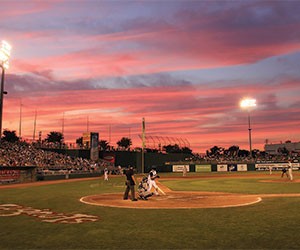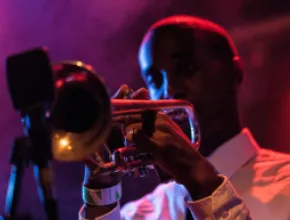Michigan may be best known for automotive history and the Great Lakes, but this state can still serve up some surprises, from the Underground Railroad history of Detroit and Ann Arbor to the covered bridge tours of Grand Rapids and Lansing’s hand-painted state capitol building.
Mix in the maritime heritage of Traverse City and Muskegon with the living history of Mackinaw City and Mackinac Island, and the Wolverine State provides time-travelling fun for everyone.
Detroit
Naturally, the Motor City is rich with automotive heritage, it is also important in another kind of legendary transport: the Underground Railroad.
“Since Canada is just across the river, Detroit was that last significant stop on the Underground Railroad,” says Carla Conner-Penzabene, director of sales for the Detroit Metro CVB. Although many sites in Detroit were involved in channeling former slaves to freedom, one of the most prominent was the First Congregational Church of Detroit, which offers attendees the opportunity to undergo the same experiences as fleeing slaves with a detailed interactive tour.
“You won’t be the same after you go through this re-enactment,” says Conner-Penzabene. “It’s a very touching experience that can change your life.”
Detroit is also home to the world’s largest African-American heritage facility, the 125,000-square-foot Charles H. Wright Museum, which offers group tours and a variety of spaces for meetings.
Another touchstone of African-American and civil rights history is on display at the Henry Ford Museum and Greenfield Village: the actual bus where Rosa Parks made her stand in 1955. The complex spotlights iconic moments in America’s history, including many originally collected by Ford himself. Noah Webster’s home and the Wright Brothers’ bicycle shop were relocated to Greenfield Village, along with Edison’s famed Menlo Park laboratory, and the museum boasts some stunning individual items like the limo used for President Kennedy’s last ride. Planners can rent the entire 90 acres of Greenfield Village or enjoy a small corporate picnic at an outdoor pavilion.
Music is another important part of Detroit’s history, and the Motown Historical Museum offers interactive group tours that spotlight the Motown sounds of the 1960s.
Groups can also choose to meet at venerable historic properties, including the Westin Book Cadillac Detroit and the Doubletree Guest Suites Fort Shelby.
In nearby Dearborn, the Dearborn Inn, A Marriott Hotel, was built in 1931 on the grounds of Ford Motor Company.
Ann Arbor
Established in 1824, Ann Arbor has progressed from its pioneer roots to a town bustling with art, history and cultural events. The city is also home to the University of Michigan, which has produced alumni like legendary actor James Earl Jones, several NASA astronauts and President Gerald R. Ford. His presidential library is on the university campus and is available for meetings.
The Ann Arbor area also shares in Michigan’s role in the Underground Railroad and automotive history; the African-American Cultural and Historic Museum offers a bus tour of important sites, and the Auto Heritage Museum in Ypsilanti gives attendees a peek into the past.
For some fresh air with that history, groups can enjoy the Historical Street program, featuring permanent sidewalk exhibits along more than a dozen historic sites in downtown.
Saginaw
Known since the early days as a town that can get the job done, Saginaw has long been an industrial leader, thanks to its location in the Great Lakes Bay region. From the lumber boom in the 1800s to crafting munitions for World War II and later becoming part of the state’s auto industry, the city offers several opportunities for heritage-seeking planners.
The Castle Museum, which houses the Historical Society of Saginaw County, is an excellent spot for meetings or lectures, while the Historical Museum and Village in nearby Bridgeport has six buildings for tours, including the old town hall, school, fire hall and barn. Planners can rent the entire town hall for events, or enjoy a picnic at the garden pagoda.
Lansing
As Michigan’s capital city, Lansing has historic actAs Michigan’s capital, Lansing offers a plethora of historic activities.
Planners can choose a murder mystery cruise aboard a J & K Steamboat paddle-wheeler on the Grand River or a tour through the House and Senate galleries in the Michigan State Capital building, an award-winning Victorian structure with more than nine acres of hand-painted surfaces.
For the ultimate elegant party, attendees will love the Turner Dodge House, a two-story home built in 1858 and now on the National Register of Historic Places. The facility can be partially or fully rented for events, and there’s even space for ballroom dancing to round out the night.
Lansing is rich with museums as well. The Michigan Historical Museum houses exhibits telling the story of the state’s land from pre-historic to modern times, while the Michigan Women’s Historic Center & Hall of Fame concentrates on the remarkable women of the state’s past. The R.E. Olds Transportation Museum features the very first Oldsmobile built in 1897, and Meridian Historical Village showcases everyday life in the 19th century with interpretive tours. All offer either event space or special arrangements for groups, and arranging speakers is easy, according to Tracy Padot, vice president for marketing and communications with the Greater Lansing CVB.
“Through our relationships with the Michigan Historical Museum, the State Capitol and Michigan State University, we can help connect planners with resources to find speakers,” she says.
Other group options include the Kellogg Hotel and Conference Center, which opened in the 1950s.
Grand Rapids
Located on the banks of the Grand River, this city owes much of its success to a historic manufacturing and agricultural background. Thanks to the lumber industry, Grand Rapids became known as Furniture City in the 1800s, and became a top producer of quality furniture for more than 100 years. It still remains a major player in the modern furniture market.
“So much of our history is tied to the rivers, lumber and agriculture,” says Andie Newcomer, convention services manager for the Grand Rapids CVB. Her fellow convention services manager, Tim Nelson, agrees.
“One site used often by groups is the Grand Rapids Public Museum overlooking the Grand River,” he says. “The museum tells the complete story of how we ended up as Furniture City, including the immigrants who came here to the economics of the era.”
The CVB professionals also put together guided tours of the area’s many covered bridges in an agricultural tour, and they can even include stops at family farms.
Another top draw for groups is Heritage Hill, a 40-block area listed on the National Register containing 1,300 historic homes from the 1840s to the 1920s. The structures cover 60 different architectural styles, ranging from working-class homes to Victorian mansions, and several accept group events, from afternoon teas to interpretive tours.
Historic properties include the Amway Grand Plaza, which originally opened in 1913 as The Pantlind hotel.
Muskegon Area
With Lake Michigan at its doorstep, Muskegon has a rich nautical history.
One of the highlights is the Great Lakes Naval Museum and Memorial, home to the World War II veteran submarine, USS Silversides. The sub completed 14 war patrols through the Pacific Theater, and now receives hundreds of group tours annually. What slips this attraction over the top are the overnight encampments where visitors spend the night on the sub, sleeping in berths and walking the decks. As an extra team-building exercise, groups can design and build their own Remotely Operated Underwater Vehicles (ROVs) and test them during their stay.
Another irresistible attraction is the White River Light Station, a lighthouse built in 1875. Visitors can take the staircase to the top and gaze out over Lake Michigan, listen to a real foghorn, and peruse fascinating exhibits detailing Michigan’s maritime history.
Kalamazoo
Kalamazoo has an eclectic history as unique as its name, from Native American heritage to cars, shopping and cereal.
The Kellogg House, built in 1925 for cereal magnate W.K. Kellogg and family, is now a restored and unique venue overlooking Gull Lake. The grounds also feature a lakeside pagoda, gardens and a carriage house.
Just outside Kalamazoo is another must-see in automotive heritage: the Gilmore Car Museum, with 200 prime selections of gearhead history.
Want to combine history and shopping? The Kalamazoo Mall opened in 1959 as the first outdoor pedestrian mall. It is home to the event-ready Kalamazoo Valley Museum, featuring interactive exhibits in science, space and local history.
Traverse City/North Michigan Resort Area
“Most of our historic sites revolve around the water,” says Mike Norton, media relations director for the Traverse City CVB. “Until the 1870s, water was the way everything got here and left here, so maritime culture is an important part of our history.”
One cultural icon is the Grand Traverse Lighthouse and Museum, located in North Michigan’s Leelanau State Park. Built in 1852, it is one of the oldest lighthouses on the Great Lakes, and visitors can tour the facility, see historic exhibits and even picnic on the grounds. Also nearby is Sleeping Bear Dunes National Lakeshore, complete with freshwater beaches, islands and hiking trails. The Sleeping Bear Point Coast Guard Station Maritime Museum is a great working model of how life-saving stations worked in the early 20th century; guides re-enact a buoy rescue drill daily for the crowds through the summer, demonstrating the importance of this 1901 life-saving station.
Mackinaw City/Mackinac Island
Along the straits of Mackinac are two destinations filled with living history: Mackinaw City and Mackinac Island.
Step onto Mackinac Island and into another age, from the Victorian homes to horse-drawn carriages taking the place of cars in this complete Michigan getaway. Visitors can even drive their own horse-drawn buggy through Mackinac Island State Park or just up the street from the Grand Hotel Mackinac Island. For something more spine-tingling, try a Haunted History Tour to learn about pioneers who never left.
In Mackinaw City, Colonial Michilimac-kinac offers incredible options for visitors, such as observing an archeological dig, watching cannon and musket firings and learning from lively demonstrations of colonial life. An interactive journey awaits groups aboard the former Coast Guard ship Icebreaker Mackinaw, as attendees learn knot-tying and navigation.
Freelancer Beth Bartlett would definitely spend the night on a haunted Michigan island if she could take her Scooby-Doo flashlight.






